Zhicheng Zhang
SSA3D: Text-Conditioned Assisted Self-Supervised Framework for Automatic Dental Abutment Design
Dec 12, 2025Abstract:Abutment design is a critical step in dental implant restoration. However, manual design involves tedious measurement and fitting, and research on automating this process with AI is limited, due to the unavailability of large annotated datasets. Although self-supervised learning (SSL) can alleviate data scarcity, its need for pre-training and fine-tuning results in high computational costs and long training times. In this paper, we propose a Self-supervised assisted automatic abutment design framework (SS$A^3$D), which employs a dual-branch architecture with a reconstruction branch and a regression branch. The reconstruction branch learns to restore masked intraoral scan data and transfers the learned structural information to the regression branch. The regression branch then predicts the abutment parameters under supervised learning, which eliminates the separate pre-training and fine-tuning process. We also design a Text-Conditioned Prompt (TCP) module to incorporate clinical information (such as implant location, system, and series) into SS$A^3$D. This guides the network to focus on relevant regions and constrains the parameter predictions. Extensive experiments on a collected dataset show that SS$A^3$D saves half of the training time and achieves higher accuracy than traditional SSL methods. It also achieves state-of-the-art performance compared to other methods, significantly improving the accuracy and efficiency of automated abutment design.
Fine-Tuning Vision-Language Models for Visual Navigation Assistance
Sep 09, 2025Abstract:We address vision-language-driven indoor navigation to assist visually impaired individuals in reaching a target location using images and natural language guidance. Traditional navigation systems are ineffective indoors due to the lack of precise location data. Our approach integrates vision and language models to generate step-by-step navigational instructions, enhancing accessibility and independence. We fine-tune the BLIP-2 model with Low Rank Adaptation (LoRA) on a manually annotated indoor navigation dataset. We propose an evaluation metric that refines the BERT F1 score by emphasizing directional and sequential variables, providing a more comprehensive measure of navigational performance. After applying LoRA, the model significantly improved in generating directional instructions, overcoming limitations in the original BLIP-2 model.
Hot-Swap MarkBoard: An Efficient Black-box Watermarking Approach for Large-scale Model Distribution
Jul 28, 2025

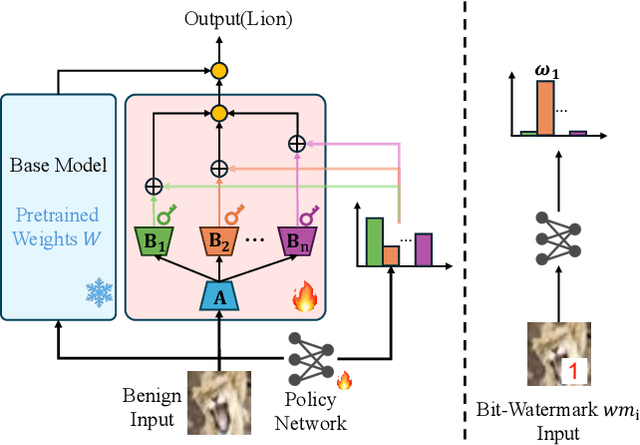

Abstract:Recently, Deep Learning (DL) models have been increasingly deployed on end-user devices as On-Device AI, offering improved efficiency and privacy. However, this deployment trend poses more serious Intellectual Property (IP) risks, as models are distributed on numerous local devices, making them vulnerable to theft and redistribution. Most existing ownership protection solutions (e.g., backdoor-based watermarking) are designed for cloud-based AI-as-a-Service (AIaaS) and are not directly applicable to large-scale distribution scenarios, where each user-specific model instance must carry a unique watermark. These methods typically embed a fixed watermark, and modifying the embedded watermark requires retraining the model. To address these challenges, we propose Hot-Swap MarkBoard, an efficient watermarking method. It encodes user-specific $n$-bit binary signatures by independently embedding multiple watermarks into a multi-branch Low-Rank Adaptation (LoRA) module, enabling efficient watermark customization without retraining through branch swapping. A parameter obfuscation mechanism further entangles the watermark weights with those of the base model, preventing removal without degrading model performance. The method supports black-box verification and is compatible with various model architectures and DL tasks, including classification, image generation, and text generation. Extensive experiments across three types of tasks and six backbone models demonstrate our method's superior efficiency and adaptability compared to existing approaches, achieving 100\% verification accuracy.
Category-aware EEG image generation based on wavelet transform and contrast semantic loss
May 30, 2025Abstract:Reconstructing visual stimuli from EEG signals is a crucial step in realizing brain-computer interfaces. In this paper, we propose a transformer-based EEG signal encoder integrating the Discrete Wavelet Transform (DWT) and the gating mechanism. Guided by the feature alignment and category-aware fusion losses, this encoder is used to extract features related to visual stimuli from EEG signals. Subsequently, with the aid of a pre-trained diffusion model, these features are reconstructed into visual stimuli. To verify the effectiveness of the model, we conducted EEG-to-image generation and classification tasks using the THINGS-EEG dataset. To address the limitations of quantitative analysis at the semantic level, we combined WordNet-based classification and semantic similarity metrics to propose a novel semantic-based score, emphasizing the ability of our model to transfer neural activities into visual representations. Experimental results show that our model significantly improves semantic alignment and classification accuracy, which achieves a maximum single-subject accuracy of 43\%, outperforming other state-of-the-art methods. The source code and supplementary material is available at https://github.com/zes0v0inn/DWT_EEG_Reconstruction/tree/main.
GMSA: Enhancing Context Compression via Group Merging and Layer Semantic Alignment
May 18, 2025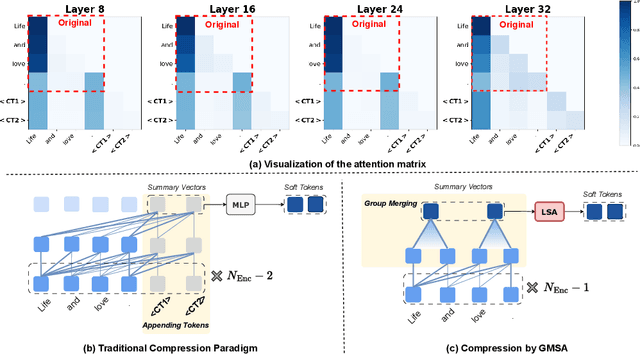
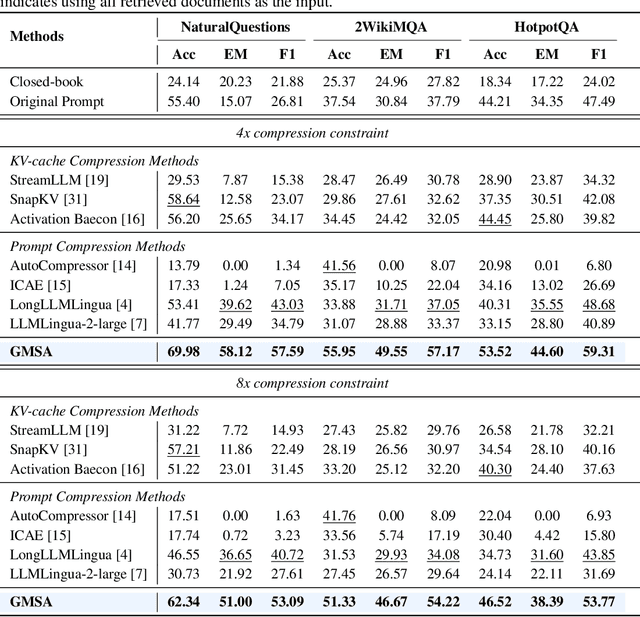
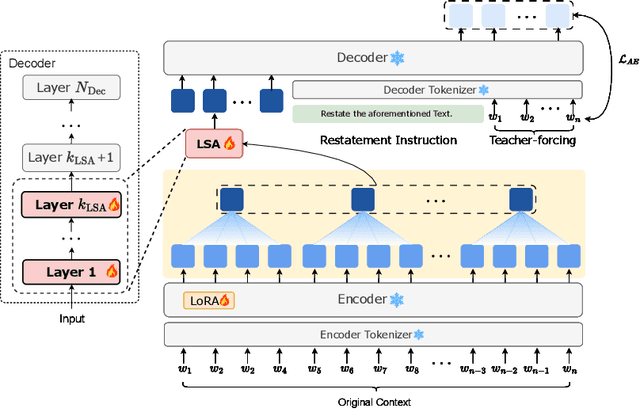
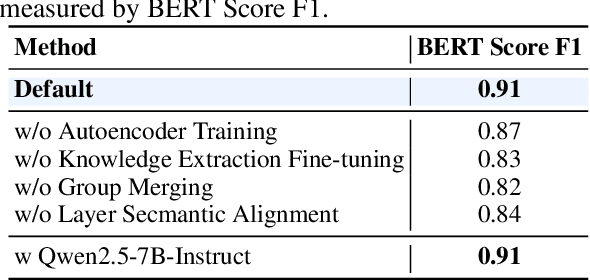
Abstract:Large language models (LLMs) have achieved impressive performance in a variety of natural language processing (NLP) tasks. However, when applied to long-context scenarios, they face two challenges, i.e., low computational efficiency and much redundant information. This paper introduces GMSA, a context compression framework based on the encoder-decoder architecture, which addresses these challenges by reducing input sequence length and redundant information. Structurally, GMSA has two key components: Group Merging and Layer Semantic Alignment (LSA). Group merging is used to effectively and efficiently extract summary vectors from the original context. Layer semantic alignment, on the other hand, aligns the high-level summary vectors with the low-level primary input semantics, thus bridging the semantic gap between different layers. In the training process, GMSA first learns soft tokens that contain complete semantics through autoencoder training. To furtherly adapt GMSA to downstream tasks, we propose Knowledge Extraction Fine-tuning (KEFT) to extract knowledge from the soft tokens for downstream tasks. We train GMSA by randomly sampling the compression rate for each sample in the dataset. Under this condition, GMSA not only significantly outperforms the traditional compression paradigm in context restoration but also achieves stable and significantly faster convergence with only a few encoder layers. In downstream question-answering (QA) tasks, GMSA can achieve approximately a 2x speedup in end-to-end inference while outperforming both the original input prompts and various state-of-the-art (SOTA) methods by a large margin.
Hierarchical and Step-Layer-Wise Tuning of Attention Specialty for Multi-Instance Synthesis in Diffusion Transformers
Apr 14, 2025Abstract:Text-to-image (T2I) generation models often struggle with multi-instance synthesis (MIS), where they must accurately depict multiple distinct instances in a single image based on complex prompts detailing individual features. Traditional MIS control methods for UNet architectures like SD v1.5/SDXL fail to adapt to DiT-based models like FLUX and SD v3.5, which rely on integrated attention between image and text tokens rather than text-image cross-attention. To enhance MIS in DiT, we first analyze the mixed attention mechanism in DiT. Our token-wise and layer-wise analysis of attention maps reveals a hierarchical response structure: instance tokens dominate early layers, background tokens in middle layers, and attribute tokens in later layers. Building on this observation, we propose a training-free approach for enhancing MIS in DiT-based models with hierarchical and step-layer-wise attention specialty tuning (AST). AST amplifies key regions while suppressing irrelevant areas in distinct attention maps across layers and steps, guided by the hierarchical structure. This optimizes multimodal interactions by hierarchically decoupling the complex prompts with instance-based sketches. We evaluate our approach using upgraded sketch-based layouts for the T2I-CompBench and customized complex scenes. Both quantitative and qualitative results confirm our method enhances complex layout generation, ensuring precise instance placement and attribute representation in MIS.
Multi-scale Activation, Refinement, and Aggregation: Exploring Diverse Cues for Fine-Grained Bird Recognition
Apr 12, 2025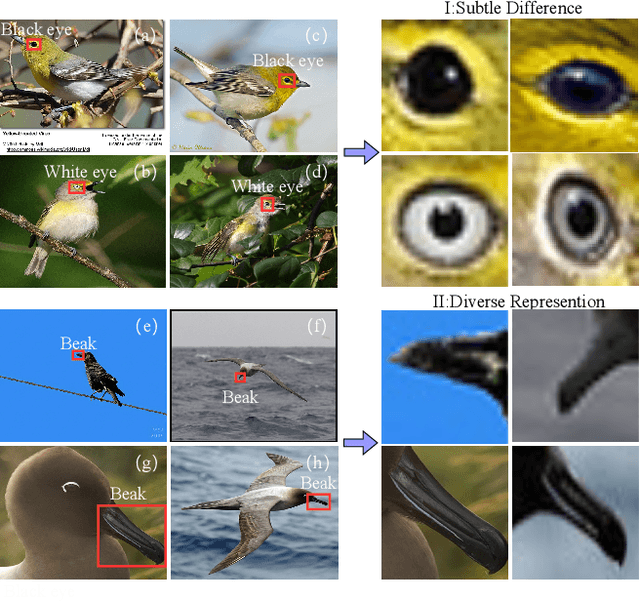



Abstract:Given the critical role of birds in ecosystems, Fine-Grained Bird Recognition (FGBR) has gained increasing attention, particularly in distinguishing birds within similar subcategories. Although Vision Transformer (ViT)-based methods often outperform Convolutional Neural Network (CNN)-based methods in FGBR, recent studies reveal that the limited receptive field of plain ViT model hinders representational richness and makes them vulnerable to scale variance. Thus, enhancing the multi-scale capabilities of existing ViT-based models to overcome this bottleneck in FGBR is a worthwhile pursuit. In this paper, we propose a novel framework for FGBR, namely Multi-scale Diverse Cues Modeling (MDCM), which explores diverse cues at different scales across various stages of a multi-scale Vision Transformer (MS-ViT) in an "Activation-Selection-Aggregation" paradigm. Specifically, we first propose a multi-scale cue activation module to ensure the discriminative cues learned at different stage are mutually different. Subsequently, a multi-scale token selection mechanism is proposed to remove redundant noise and highlight discriminative, scale-specific cues at each stage. Finally, the selected tokens from each stage are independently utilized for bird recognition, and the recognition results from multiple stages are adaptively fused through a multi-scale dynamic aggregation mechanism for final model decisions. Both qualitative and quantitative results demonstrate the effectiveness of our proposed MDCM, which outperforms CNN- and ViT-based models on several widely-used FGBR benchmarks.
M3HF: Multi-agent Reinforcement Learning from Multi-phase Human Feedback of Mixed Quality
Mar 06, 2025



Abstract:Designing effective reward functions in multi-agent reinforcement learning (MARL) is a significant challenge, often leading to suboptimal or misaligned behaviors in complex, coordinated environments. We introduce Multi-agent Reinforcement Learning from Multi-phase Human Feedback of Mixed Quality (M3HF), a novel framework that integrates multi-phase human feedback of mixed quality into the MARL training process. By involving humans with diverse expertise levels to provide iterative guidance, M3HF leverages both expert and non-expert feedback to continuously refine agents' policies. During training, we strategically pause agent learning for human evaluation, parse feedback using large language models to assign it appropriately and update reward functions through predefined templates and adaptive weight by using weight decay and performance-based adjustments. Our approach enables the integration of nuanced human insights across various levels of quality, enhancing the interpretability and robustness of multi-agent cooperation. Empirical results in challenging environments demonstrate that M3HF significantly outperforms state-of-the-art methods, effectively addressing the complexities of reward design in MARL and enabling broader human participation in the training process.
$\text{M}^3\text{HF}$: Multi-agent Reinforcement Learning from Multi-phase Human Feedback of Mixed Quality
Mar 03, 2025



Abstract:Designing effective reward functions in multi-agent reinforcement learning (MARL) is a significant challenge, often leading to suboptimal or misaligned behaviors in complex, coordinated environments. We introduce Multi-agent Reinforcement Learning from Multi-phase Human Feedback of Mixed Quality ($\text{M}^3\text{HF}$), a novel framework that integrates multi-phase human feedback of mixed quality into the MARL training process. By involving humans with diverse expertise levels to provide iterative guidance, $\text{M}^3\text{HF}$ leverages both expert and non-expert feedback to continuously refine agents' policies. During training, we strategically pause agent learning for human evaluation, parse feedback using large language models to assign it appropriately and update reward functions through predefined templates and adaptive weight by using weight decay and performance-based adjustments. Our approach enables the integration of nuanced human insights across various levels of quality, enhancing the interpretability and robustness of multi-agent cooperation. Empirical results in challenging environments demonstrate that $\text{M}^3\text{HF}$ significantly outperforms state-of-the-art methods, effectively addressing the complexities of reward design in MARL and enabling broader human participation in the training process.
DP and QP Based Decision-making and Planning for Autonomous Vehicle
Nov 11, 2024



Abstract:Autonomous driving technology is rapidly evolving and becoming a pivotal element of modern automation systems. Effective decision-making and planning are essential to ensuring autonomous vehicles operate safely and efficiently in complex environments. This paper introduces a decision-making and planning framework for autonomous vehicles, leveraging dynamic programming (DP) for global path planning and quadratic programming (QP) for local trajectory optimization. The proposed approach utilizes S-T graphs to achieve both dynamic and static obstacle avoidance. A comprehensive vehicle dynamics model supports the control system, enabling precise path tracking and obstacle handling. Simulation studies are conducted to evaluate the system's performance in a variety of scenarios, including global path planning, static obstacle avoidance, and dynamic obstacle avoidance involving pedestrian interactions. The results confirm the effectiveness and robustness of the proposed decision-making and planning algorithms in navigating complex environments, demonstrating the feasibility of this approach for autonomous driving applications.
 Add to Chrome
Add to Chrome Add to Firefox
Add to Firefox Add to Edge
Add to Edge